Standing Waves (Resonance)
A standing wave is created when two identical waves are travelling in the opposite direction in the same medium - this often happens as the result of reflection. For the standing wave to be created, the frequency of the waves must be some multiple of the natural frequency of the medium.. A standing wave is another example of resonance.
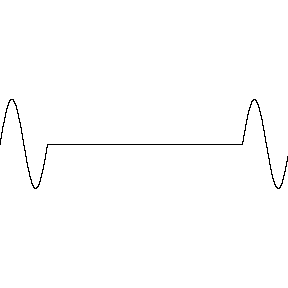
A spring or pendulum has only one resonant frequency, whereas a string or musical pipe has an infinite number of resonant frequencies, each some whole number multiple of the medium's fundamental natural frequency.
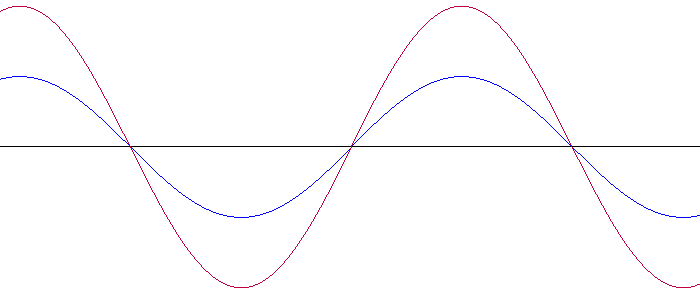
the blue and green waves meet to create the standing red wave
In a standing wave, the wave does not travel through the medium. Parts of the medium (the anti-nodes) are always forced to vibrate between maximum and minimum amplitudes, while other parts (the nodes) don't vibrate at all.
Sound
Sound is a longitudinal pressure wave as shown in the animatiton below. However, since this type of wave is hard to diagram, it is often shown using transverse wave diagrams.

Sound needs a medium to travel through. The speed of sound is different in different materials. It is faster in solids than liquids. It is faster in liquids than in a gas. For air there is a formula that allows you to approximate the speed of sound if you know the temperature:

The pitch of a sound refers to whether the sound is high (like a piccolo) or low (like a tuba). Pitch is another word for frequency. Human ears can respond to frequencies from around 20Hz to 20000Hz - this is known as the audible range. This spectrum narrows with age and with how you treat your hearing system.
The loudness of a sound is sometimes refered to as its intensity. Loudness is related to the amplitude of the sound wave and refers to the energy it carries. Remember that energy is related to the square of the wave's amplitude.
Musical Instruments
The quality of a musical instrument depends upon its ability to resonate at the frequencies of the notes it is meant to play. Standing waves are created in the strings or pipes that the instrument are made of and these in turn set up vibrations in the air to carry the musical notes from the instrument.
This series of notes is an introduction to musical instrument design. You will be introduced to the relationship between instrument length and musical notes.
Stringed Instruments
Stringed instruments (violins, guitars, pianos, etc. . .) have strings that are fixed at both ends and these strings are forced to vibrate at their resonant frequencies.
There is a pattern to these vibrations and to the resonant frequencies at which a string may vibrate.
Below is a diagram of the first possible mode of vibration - the fundamental frequency at which a string vibrates.

The note this string will play - its pitch, or frequency, depends upon the tension in the string and the string's mass per unit length - both of which determine the speed of the wave in the string. We will focus, however, on the relationship between length and frequency. For a string of length L:
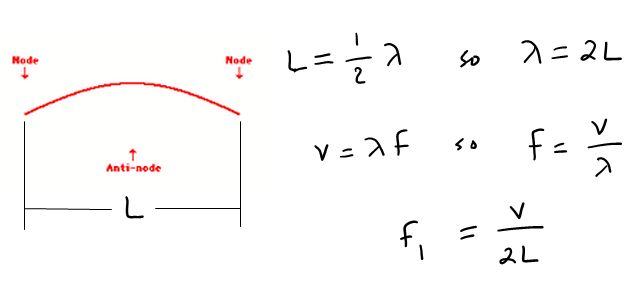
The second and third modes of vibration follow a similar pattern and produce similar formulas for the frequencies of the notes played.
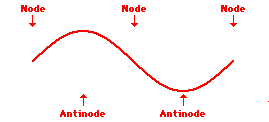


From this pattern we get the general formula for the frequency of the note played as a function of the length of the string:

The first frequency, called the fundamental frequency, is also called the first harmonic.
open pipe wind instruments
Some wind instruments are made of pipes that are open at both ends. Examples of these include flutes and some of the pipes on a pipe organ.
Forcing air across the opening at one end at just the right speed produces a standing pressure wave in the pipe, forcing the air inside it to resonate. Anti-nodes occur at the open end of the pipes where the air vibrates back and forth at maximum amplitude.
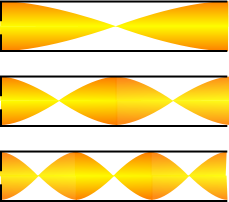
open pipes and the 1st three modes of vibration
From the diagrams above you should be able to see that at the first mode of vibration, the length of pipe produces half of a wavelength. (Note: sound is really a longitudinal wave, but as this is hard to diagram, transverse waveforms are used instead.) The 2nd mode produces a full wavelegth, and the third mode 1.5 wavelengths. This is exactly the same progression seen in strings. The same formulas then apply to open pipes that apply to strings.

closed pipe wind instruments
Many instruments are considered to be closed at one end. All of the reed woodwinds (clarinets, saxophones, etc. . .) and all of the brass instruments (trumpets, for example) are made of pipes with one end open to the atmosphere and the other end closed at the player's mouth. The vibrations from the reed or from the player's lips force the air in the pipe to resonate.
The mathematical progression between frequency and length is different for closed pipes. Consider the diagrams below.
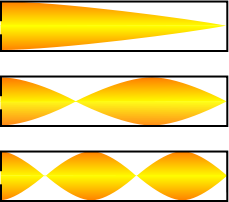
By counting the number of complete wavelengths in each length of pipe, we see that:
- 1st mode: L = λ/4
- 2nd mode: L = 3λ/4
- 3rd mode: L = 5λ/4
The consequences of this are:
- closed pipes do not play as many notes as open pipes
- closed pipes can play lower pitched notes than the same length open pipe
Our mathematical relationships are:

Example 1 - Stringing you along
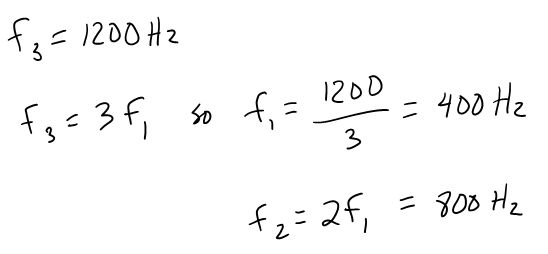
Example 2 - Totally tubular
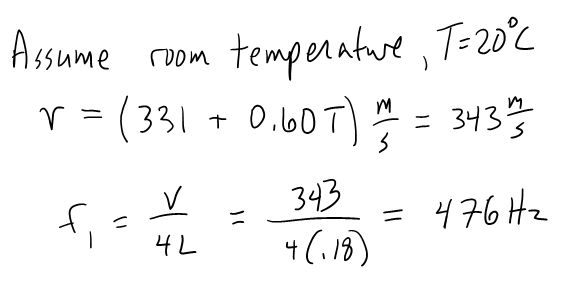
Example 3 - Tooting your own horn
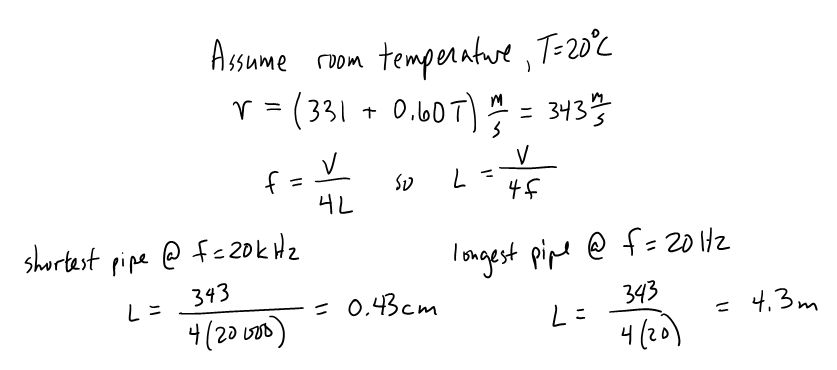
Doppler Effect
When you hear a sound, you are experiencing the wavefronts of a pressure wave striking your eardrum. The pitch (frequency) of the sound you hear is the frequency at which your ear drums are hit by the pressure wave - not necessarily the same frequency at which the waves were made.
Consider the first animation below that models sound waves emminating from a stationary source. If you, the listener, were are rest, then you would hear the same pitch that the source makes.
However, if you were moving towards the source, the the wavefronts would strike you more often - more frequently - that when you were at rest. You would hear a higher pitch than if you were at rest. What would happen if you were walking away from the source?
This phenomenon is known as the doppler effect - the apparent change in frequency of a wave caused by the relaive motion between the source and the observer of the wave.

In this second animation below, the source of the sound is moving. You can clearly see that the wave "bunch up" ahead of the source and "spread out" behind it. A stationary listener would hear a higher pitch as the source approaches him and a lower pitch after it passes. The source would always hear the same pitch. Push the button below to hear a passing train the demonstrates this effect.

The formulas for calculating the shift in frequency heard by the observer are given below.
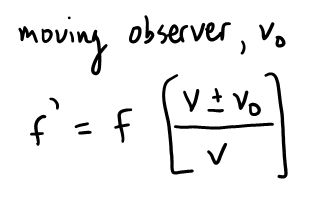
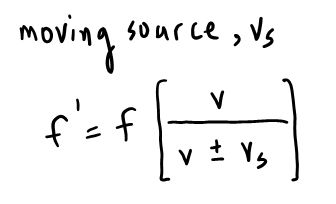
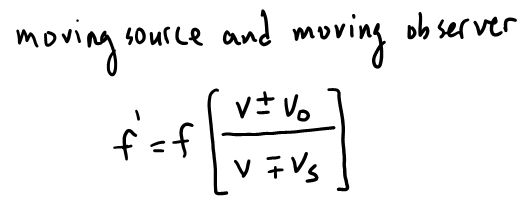
Example - Waiting for the bus

Example - Riding the bus
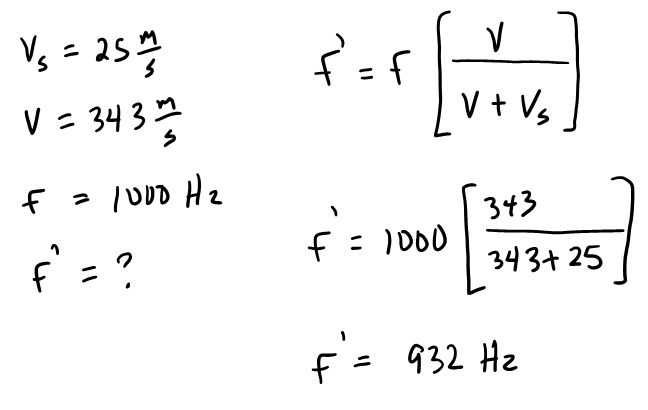
Example - Bus Retreat
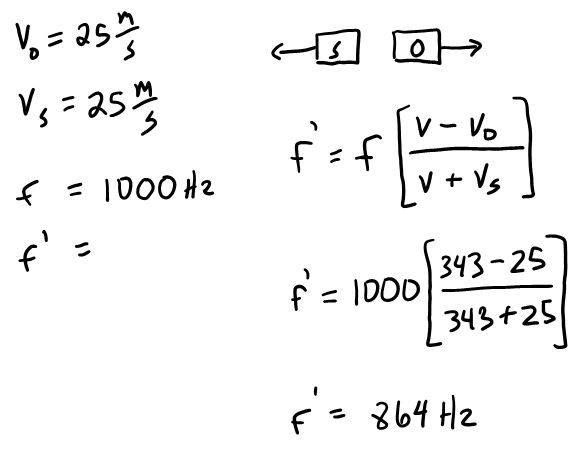
Sonic Boom!
What happens if the source is moving at the same speed as the sound waves it is producing? What if the source is moving faster than sound? Examine the animations below.

at the speed of sound

faster than the speed of sound
All the wavefronts from the pressure wave build up in a cone that trails the moving source. The surface of this cone forms what is called a shock wave that moves at the speed of sound.